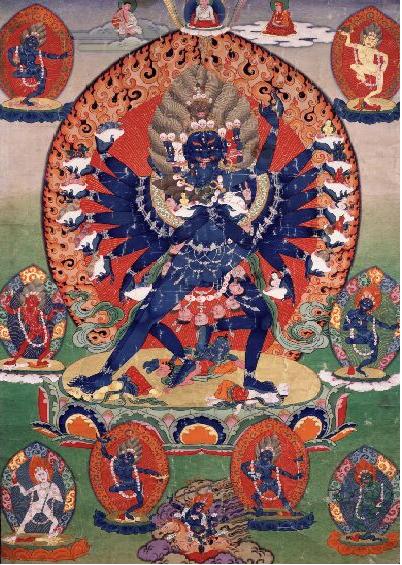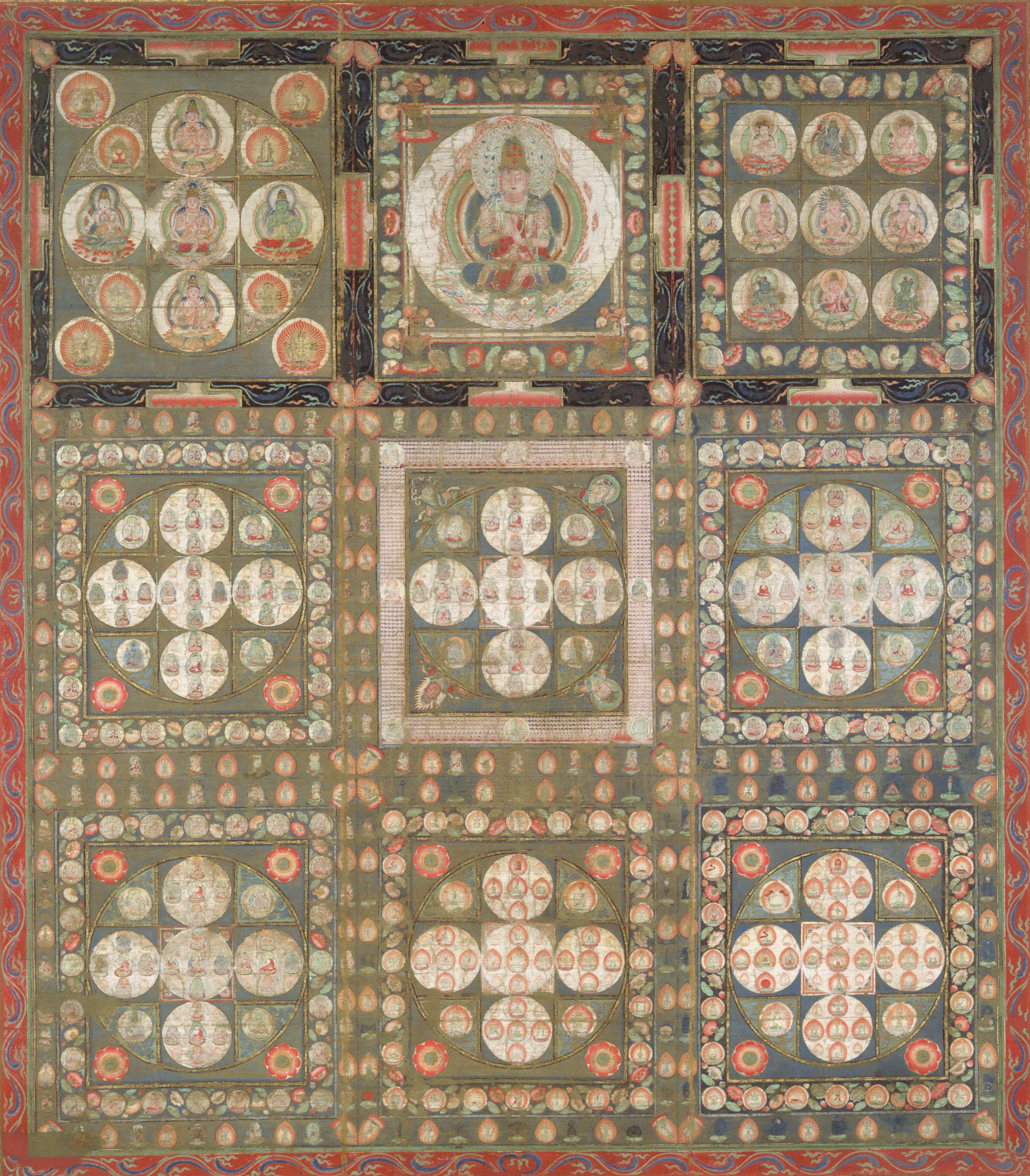|
Virūpa
Virupa (; Tib. ''bi ru pa'' or ''bir wa pa, ''), also known as Virupaksa and Tutop Wangchuk, was an 8th–9th century Indian mahasiddha and yogi, and the source of important cycles of teachings in Vajrayana Buddhism. Origin of Virupa/Birubapa Virupa is especially known as the source of the ''Lamdré'' (''Path–Fruit'', Skt. '' mārga–phala'') system held by the Sakya school, and is thus seen as the Indian founder of their lineage. The ''Vajra Verses'', pith instructions on the Hevajra tantra, are also attributed to him. Tibetan sources mention that Virupa was born in Tripura in east India and studied at the Somapura Mahavihara as a monk, practicing tantra, particularly the Cakrasamvara. Alternatively, Indian sources such as the ''Navanathacaritramu'' claim that he was born in Maharashtra around the Konkan region to a pious Brahmin couple. The Tibetan historian Taranatha also says that Virupa lived in Maharashtra. Tibetan sources further state that after years of tantric p ... [...More Info...] [...Related Items...] OR: [Wikipedia] [Google] [Baidu] |
Lamdré
Lamdré is a meditative system in Tibetan Buddhism rooted in the view that the result of its practice is contained within the path. The name "lamdré" means the "path" () with its fruit ). In Tibet, the lamdré teachings are considered the ''summum bonum'' of the Sakya school. History According to traditional accounts, the lamdré teachings were originally bestowed upon Virūpa, an Indian monk, by the tantric deity Nairātmyā. By practicing the instructions given to him, Virūpa is said to have realized enlightenment. Hagiographical accounts of Virūpa's exploits record outrageous events, including binge drinking, seducing women, and destroying non-Buddhist (Skt. ''tīrtika'') religious sites. Davidson suggests that this depiction shows the laxity of Buddhist morals during the Indian medieval period, but Wedemeyer suggests that the behavior shown in esoteric Buddhist hagiographies is intentionally scandalous, forming a social commentary on broader issues being discussed in th ... [...More Info...] [...Related Items...] OR: [Wikipedia] [Google] [Baidu] |
Mahasiddha
Mahasiddha (Sanskrit: ''mahāsiddha'' "great adept; ) is a term for someone who embodies and cultivates the "siddhi of perfection". A siddha is an individual who, through the practice of sādhanā, attains the realization of siddhis, psychic and spiritual abilities and powers. Mahasiddhas were practitioners of yoga and tantra, or ''tantrika''s. Their historical influence throughout the Indian subcontinent and the Himalayas was vast and they reached mythic proportions as codified in their songs of realization and hagiography, hagiographies, or Namtar (biography), namtars, many of which have been preserved in the Tibetan Buddhist canon. The Mahasiddhas are identified as founders of Vajrayana traditions and lineage (Buddhism), lineages such as Dzogchen and Mahamudra, as well as among Bon, Bön, Nath, Nāth, and Tamil Siddhar, siddhars, with the same Mahasiddha sometimes serving simultaneously as a founding figure for different traditions. Robert Thurman explains the symbiotic relati ... [...More Info...] [...Related Items...] OR: [Wikipedia] [Google] [Baidu] |
Sakya (Tibetan Buddhist School)
The ''Sakya'' (, 'pale earth') school is one of four major schools of Tibetan Buddhism, the others being the Nyingma, Kagyu, and Gelug. It is one of the Red Hat Orders along with the Nyingma and Kagyu. Origins Virūpa, 16th century. It depicts a famous episode in his hagiography when he stopped the sun in the sky. The name ''Sakya'' ("pale earth") derives from the unique grey landscape of the Ponpori Hills in southern Tibet near Shigatse, where Sakya Monastery, the first monastery of this tradition, and the seat of the Sakya School was built by Khon Konchog Gyalpo (1034–1102) in 1073. The Sakya tradition developed during the second period of translation of Buddhist scripture from Sanskrit into Tibetan in the late 11th century. It was founded by Drogmi, a famous scholar and translator who had studied at the Vikramashila directly under Naropa, Ratnākaraśānti, Vāgīśvarakīrti and other great Pandita (Buddhism), panditas from India for twelve years. Khon Konchog Gya ... [...More Info...] [...Related Items...] OR: [Wikipedia] [Google] [Baidu] |
Hevajra
Hevajra ( Tibetan: kye'i rdo rje / kye rdo rje; Chinese: 喜金剛 Xǐ jīngāng / 呼金剛 Hū jīngāng;) is one of the main yidams (enlightened beings) in Tantric, or Vajrayana Buddhism. Hevajra's consort is Nairātmyā ( Tibetan: bdag med ma). History India The Hevajra Tantra, a ''yoginītantra'' of the '' anuttarayogatantra'' class, is believed to have originated between the late 8th (Snellgrove), and the late 9th or early 10th (Davidson), centuries in eastern India, possibly Kamarupa. Tāranātha lists Saroruha and Kampala (also known as Lva-va-pā, Kambhalī, and Śrī-prabhada") as its "bringers": . . . the foremost yogi Virupa meditated on the path of Yamāri and attained siddhi under the blessings of Vajravārāhi, . . . His disciple Dombi Heruka..understood the essence of the Hevajra Tantra, and composed many śāstras like the ''Nairātmā-devi-sādhana'' and the ''Sahaja-siddhi''. He also conferred abhiṣeka on his own disciples. After this, two ācār ... [...More Info...] [...Related Items...] OR: [Wikipedia] [Google] [Baidu] |
Vajrayana
''Vajrayāna'' (; 'vajra vehicle'), also known as Mantrayāna ('mantra vehicle'), Guhyamantrayāna ('secret mantra vehicle'), Tantrayāna ('tantra vehicle'), Tantric Buddhism, and Esoteric Buddhism, is a Mahāyāna Buddhism, Mahāyāna Buddhist tradition that emphasizes Eastern esotericism, esoteric practices and rituals aimed at Sudden awakening, rapid spiritual awakening. Emerging between the 5th and 7th centuries CE in medieval India, Vajrayāna incorporates a Tibetan tantric practice, range of techniques, including the use of mantras (sacred sounds), dhāraṇīs (mnemonic codes), mudrās (symbolic hand gestures), mandalas (spiritual diagrams), and the visualization of Buddhist deities, deities and Buddhahood, Buddhas. These practices are designed to transform ordinary experiences into paths toward Enlightenment in Buddhism, enlightenment, often by engaging with aspects of Taṇhā, desire and Dvesha, aversion in a ritualized context. A distinctive feature of Vajrayāna is ... [...More Info...] [...Related Items...] OR: [Wikipedia] [Google] [Baidu] |



